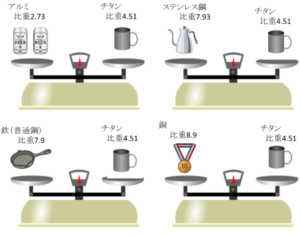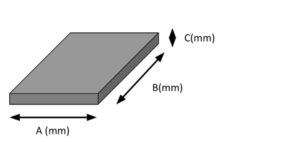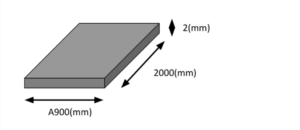contents
Outline of Titanium
Titanium is a metal that is absolutely resistant to seawater. In addition, it is lighter than steel or iron, biocompatible, and friendly to the human body and the environment.
Recently, many cases have emerged in which roof tiles have been converted to titanium for long-term durability and weight reduction, as well as improved earthquake resistance.
Here is how to calculate the weight of cutting-edge, highly durable titanium.
Specific Gravity of Titanium
Specific gravity is the ratio of the density of the target substance to that of a reference standard.
The reference material varies depending on the state of the target substance, but if the target substance is a liquid or an individual, it is water.
If it is a gas, it is air at the same temperature and pressure.
The formula for specific gravity is: “Specific gravity = Density of material / Density of water (approx. 1.00) = Density of material
Specific gravity is expressed as
The specific gravity of titanium is 4.51.
Compared to other

Titanium Strength

Titanium is used for rocket and aircraft parts that require high strength.
As evidence, titanium is three times stronger than aluminum and twice as strong as steel. Therefore, titanium is a high-strength metal. Therefore, it is not easily broken even when subjected to strong impacts. Furthermore, titanium is also heat resistant.
Comparing the melting points of materials, iron is 1530°C, copper is 1080°C, and aluminum is 660°C. Titanium is more heat resistant than iron at 1660°C.
Therefore, when comparing stainless steel and titanium, stainless steel is basically stronger, but titanium is stronger at higher temperatures.
In summary, titanium has superior strength and heat resistance.
How to calculate the weight of titanium

Unify the units in mm. (since board thickness is in mm)
Convert length and width to m.
<Calculation
A(mm)/1000 x B(mm)/1000 x C(mm) x 4.51 (specific gravity)
The value that appears here is kg.
Now for the exercise.
For example, assume a 900 mm x 2000 mm board with a thickness of 2 mm.

<Calculation>
900/1000 x 2000/1000 x 2(mm) x 4.51(specific gravity)
= 0.9 x 2 x 2 x 4.51
= 16.236 kg
The result is as follows.
Finally
Basically, we just take the volume and multiply by the specific gravity, but recently there are more and more cut plates, shaped plates, pipes with holes, etc., so we have to expand the material and calculate more and more.
